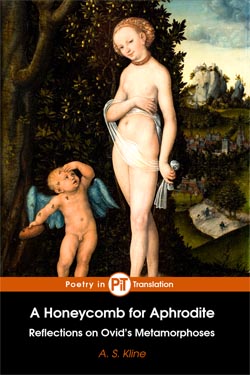A Honeycomb For Aphrodite
Reflections On Ovid’s Metamorphoses
A. S. Kline
With illustrations by Crispijn de Passe (The Netherlands, 1564 - 1637) courtesy of the Rijksmuseum.

For joy’s sake, from my hands,
take some honey and some sun
Contents
- Part I: Chapters I-V (The Golden Honeycomb | The Dual Paths of Art | The Structure of the Metamorphoses | Ovid’s Interest in Myth | Nature,The Matrix)
- Part II: Chapters VI-X (The Power of the Gods | The Nature of the Male Gods | The Nature of the Goddess | Justice, Moderation, Order and Rights | Vengeance and Destiny)
- Part III: Chapters XI-XV (Magic and Prophecy | Fate and Error | Lust, Love, Sexuality and Betrayal | Loyalty and Marriage | Pride and Vanity)
- Part IV: Chapters XVI-XXII (Respect and Impiety | Crime and Punishment | Ovid’s attitude to War and Violence | Tenderness, Pity, Pathos and Regret | Ovid’s Civilised Values, the Sacred Other | The Later Influence of the Metamorphoses | The Wings of Daedalus)
About This Work
With this innovative analysis of Ovid’s Metamorphoses the author provides an essential companion volume to his translation of the work itself. The nature and structure of Ovid’s brilliant retelling of Greek myths is explained, while emphasising his broadly humanist approach. The concept of loosely connected tales linked and sustained by the author’s style, personality, and world-view, is contrasted with the epic mode as exemplified by Virgil’s Aeneid, while seen as being justified in its own right.
The exploration of structure is deepened by detailed discussion of the key concepts and themes which run throughout the work. These range from the religious and mythical, to the social and ethical, and highlight Ovid’s prime areas of interest and personal attitudes and values, while placing the Metamorphoses within the context of his other literary achievements, and the milieu of Augustan Rome. The manner in which these common concepts and themes are echoed and expanded through disparate myths and tales is highlighted by copious references to specific examples and illustrative passages in the work, allowing the reader rapid access to the supporting evidence within the text itself.
A Honeycomb for Aphrodite argues for a more thoughtful appreciation of Ovid’s major creation, claiming that his design is more than just a vivid and charming re-telling of the Greek originals, but a deeply-felt humanist development, in which civilised Roman values re-interpret the ancient natural and spiritual environment of Ovid’s Greek sources in a manner destined to influence the whole of European culture, not simply the Medieval and Renaissance periods. Ovid is here seen as strengthening and enriching an alternative view of life to that presented by imperialistic, heroic or tragic literature; a view in which tenderness and pathos, pity and moderation transform the human, and humanise the world.
© Copyright A. S. Kline 2003 All Rights Reserved
This work may be freely reproduced, stored and transmitted, electronically or otherwise, for any non-commercial purpose. Conditions and Exceptions apply.
Last Modified 30 January 2015